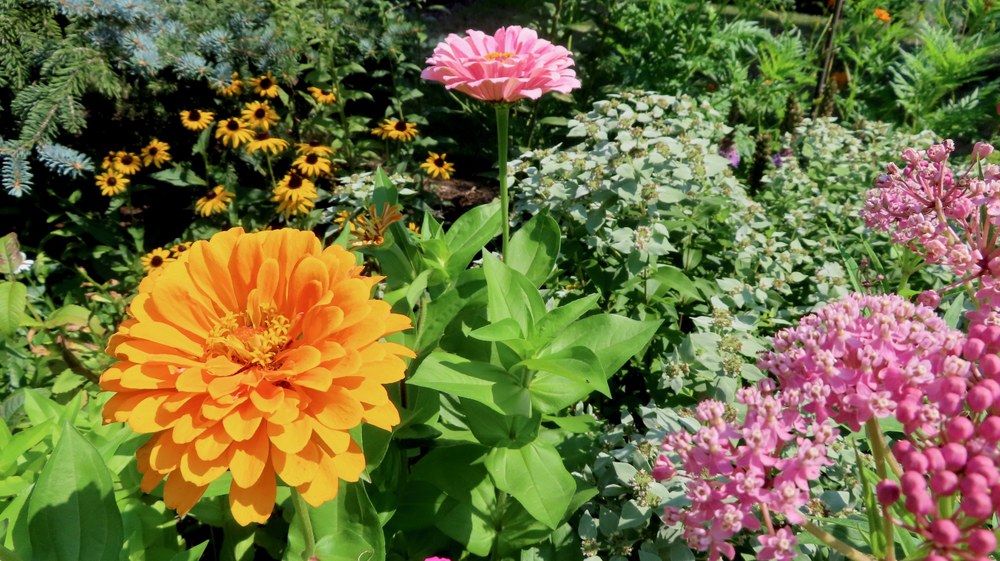Posted: March 18, 2025
Spring is here! It's the growing season and an exciting time for gardeners. Time to choose what to plant, try new experiments, tend to established gardens, and look forward to seeing our favorite pollinators and backyard visitors.

Native plants contribute to climate resilience and support local ecosystems (Photo Credit: Sherrie McCleary).
What gardener wouldn't want a longer growing season to enjoy all these delightful activities a bit longer? They say, "It's Climate Change." Wait! What does that really mean to you and your gardens?
Climate change, the long term shift in the Earth's average temperatures and weather conditions, has been researched and studied for many years. Some people may think it is a future phenomenon and will not impact them. Others may tune out when discussion turns to greenhouse gases, fossil fuels, carbon dioxide and methane gas, thinking those topics are better left to the scientists. The reality is climate change is happening now and happening here. Research shows results related to warmer temperatures, extreme rainfall events, drought, pest and pathogen imbalances, and disruption to ecosystems.
Climate change may impact which plants will flourish in your gardens. The USDA Plant Hardiness Zone Map is used by gardeners to determine which plants are likely or not likely to survive in their region. This map is based on annual average minimum winter temperatures. The latest map released in 2023 shows changes for several areas of Pennsylvania. In Franklin County PA we are currently in zone 7a. That is a change from 6a when it was last published in 2012. While changes to the map cannot be directly attributed to climate change, the general trend is one of warming.
It's wise to check the recommended hardiness zone for any perennials, shrubs, and trees you may be planning to add to your gardens and landscape. This information can usually be found on the plant tag or while researching other attributes for a specific plant. Also, some plants you already have may not do as well if these warming trends continue. For instance, plants that require a period of cold temperatures, such as cold stratification which naturally occurs during winter, may be impacted by warmer winters. With warmer winters you may get anxious to plant earlier in the spring. Climate change doesn't just mean warm weather; however, it also brings extremes and fluctuations between low and high temperatures. An abrupt dip to freezing temperatures, 32ºF (0ºC), can be detrimental to early plantings. Another concern is if PA continues to warm and our hardiness zone continues to rise, more southern invasive species may gain a foothold here. Be vigilant in eradicating unwanted plants and choose native plants that are appropriate to the region and preserve Pennsylvania's biodiversity.
Be aware that insect populations may increase with warmer temperatures and longer growing seasons. Insects may produce multiple generations per year during a longer growing season and speed up their development with warmer temperatures (Cho, 2022). Plant pathogens may also flourish in warmer weather. Matt Kasson, professor of plant pathology at West Virginia University, writes "plant pathogens may take advantage of milder winter temperatures, which leads to prolonged saturation of soils instead of freezing" (Kasson, 2024). In wet, waterlogged soil, organisms such as fungi and oomycetes have more opportunity to develop in plant roots, leading to more disease. Plants already stressed by extremes in temperatures and weather events may be more vulnerable to these changes.
Important connections between pollinators, birds, insects, wildlife, and the plants they depend on can also be disrupted by climate change. Pollinators, such as hummingbirds and bees, may arrive too early or too late to feed on the flowers on which they normally rely. Native bees, some known as specialists, rely on certain plants for food. If that species of plant emerges and develops earlier than usual, their food sources can be compromised. Studies done by the Center for Pollinator Research at Penn State have shown that wild bees are most affected by temperature and precipitation extremes.
As gardeners, we are stewards and guardians of our environment. What can we do to help? We can begin by making a difference in our own backyards. We can decrease carbon emissions by avoiding use of gasoline powered garden tools and plant native plants and trees that benefit our local ecosystem. We can create nesting sites and gardens that support pollinators and beneficial insects. Conserving water, which is especially important during drought and heat waves, can be accomplished by mulching, installing rain barrels and using drip irrigation. Other ideas that can be used in and around your home can be found at the United States Environmental Protection Agency's article "What You Can Do about Climate Change".
Staying current on research and articles will help you to navigate some of the challenges brought about by climate change. Awareness, choosing suitable plants for your home garden, adopting integrative pest management practices, and maintaining a healthy garden will serve you much better than "a longer growing season." Happy Spring! It's time to get growing!
References
Cho, R. (2022). "How Climate Change Will Affect Plants". Columbia Climate School: State of the Planet.
Espindola, A. (2021). "Climate Change Impacts on Pollinators and Pollination."
National Wildlife Federation. "Gardening for Climate Change."
Kasson, M. (2024). "Climate Change is shifting plant growth zones. Here's what to know for your Garden This Year."
LaJeunesse, S. (2021). "Climate change reduces the abundance and diversity of wild bees." Penn State Research.
Shepard, M. (2024). "Gardening and climate change." Penn State Extension.
United State Environmental Protection Agency. (2025). What You Can Do About Climate Change?
Written By:
Sherrie McCleary, Master Gardener, Franklin County

